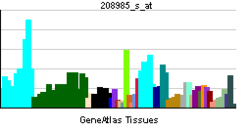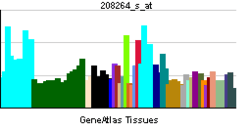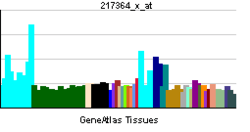EIF3J
Eukaryotic translation initiation factor 3 subunit J is a protein that in humans is encoded by the EIF3J gene.[1][2]
Interactions
EIF3J has been shown to interact with EIF3A.[1][3]
References
- ↑ 1.0 1.1 Block KL, Vornlocher HP, Hershey JW (Dec 1998). "Characterization of cDNAs encoding the p44 and p35 subunits of human translation initiation factor eIF3". J. Biol. Chem. 273 (48): 31901–8. doi:10.1074/jbc.273.48.31901. PMID 9822659.
- ↑ "Entrez Gene: EIF3S1 eukaryotic translation initiation factor 3, subunit 1 alpha, 35kDa".
- ↑ Mayeur GL, Fraser CS, Peiretti F, Block KL, Hershey JW (Oct 2003). "Characterization of eIF3k: a newly discovered subunit of mammalian translation initiation factor elF3". Eur. J. Biochem. 270 (20): 4133–9. doi:10.1046/j.1432-1033.2003.03807.x. PMID 14519125.
Further reading
- Asano K, Kinzy TG, Merrick WC, Hershey JW (1997). "Conservation and diversity of eukaryotic translation initiation factor eIF3". J. Biol. Chem. 272 (2): 1101–9. doi:10.1074/jbc.272.2.1101. PMID 8995409.
- Méthot N, Rom E, Olsen H, Sonenberg N (1997). "The human homologue of the yeast Prt1 protein is an integral part of the eukaryotic initiation factor 3 complex and interacts with p170". J. Biol. Chem. 272 (2): 1110–6. doi:10.1074/jbc.272.2.1110. PMID 8995410. Vancouver style error (help)
- Bushell M, Wood W, Clemens MJ, Morley SJ (2000). "Changes in integrity and association of eukaryotic protein synthesis initiation factors during apoptosis". Eur. J. Biochem. 267 (4): 1083–91. doi:10.1046/j.1432-1327.2000.01101.x. PMID 10672017.
- Valásek L, Hasek J, Nielsen KH, Hinnebusch AG (2001). "Dual function of eIF3j/Hcr1p in processing 20 S pre-rRNA and translation initiation". J. Biol. Chem. 276 (46): 43351–60. doi:10.1074/jbc.M106887200. PMID 11560931. Vancouver style error (help)
- Mayeur GL, Fraser CS, Peiretti F, Block KL, Hershey JW (2003). "Characterization of eIF3k: a newly discovered subunit of mammalian translation initiation factor elF3". Eur. J. Biochem. 270 (20): 4133–9. doi:10.1046/j.1432-1033.2003.03807.x. PMID 14519125.
- Fraser CS, Lee JY, Mayeur GL, Bushell M, Doudna JA, Hershey JW (2004). "The j-subunit of human translation initiation factor eIF3 is required for the stable binding of eIF3 and its subcomplexes to 40 S ribosomal subunits in vitro". J. Biol. Chem. 279 (10): 8946–56. doi:10.1074/jbc.M312745200. PMID 14688252.
- Beausoleil SA, Villén J, Gerber SA, Rush J, Gygi SP (2006). "A probability-based approach for high-throughput protein phosphorylation analysis and site localization". Nat. Biotechnol. 24 (10): 1285–92. doi:10.1038/nbt1240. PMID 16964243. Vancouver style error (help)
- Olsen JV, Blagoev B, Gnad F, Macek B, Kumar C, Mortensen P et al. (2006). "Global, in vivo, and site-specific phosphorylation dynamics in signaling networks". Cell 127 (3): 635–48. doi:10.1016/j.cell.2006.09.026. PMID 17081983.
- ElAntak L, Tzakos AG, Locker N, Lukavsky PJ (2007). "Structure of eIF3b RNA recognition motif and its interaction with eIF3j: structural insights into the recruitment of eIF3b to the 40 S ribosomal subunit". J. Biol. Chem. 282 (11): 8165–74. doi:10.1074/jbc.M610860200. PMID 17190833.
| ||||||||||||||||||||||||||||||||||||||||||||||||||||||||||||||||||||||||||||||||


